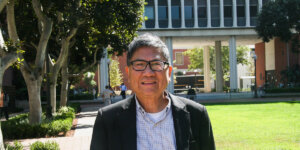
Jong-Shi Pang, Epstein Family Chair and professor of industrial and systems engineering. Photo/Annie Chen
For Jong-Shi Pang, Epstein Family Chair and professor of industrial and systems engineering at the USC Viterbi School of Engineering, mathematics is his secret weapon. A skill he uses to bring accountability to a broad range of industries such as engineering and economics, using quantifiable facts and logical arguments.
“When people ask me what I do, I tell them my job is to make researchers honest in their work through mathematics. With all due respect to their professions,” Pang laughed.
“Rather than letting people get away with making unsubstantiated claims, I use a mathematical approach to make sure what they say is correct,” he said. “I think this is part of the duty of a scientist — to quantify claims and not just allow arbitrary statements,” Pang said.
Now, one of the key industry associations in his field, the Institute for Operations Research and the Management Sciences (INFORMS), has honored Pang’s life’s work with the 2019 John von Neumann Theory Prize, awarded at the INFORMS annual meeting in Seattle on October 20 – 23, 2019.
The prize is awarded each year to a researcher who has made fundamental, ongoing contributions to theory in operations research and the management sciences. At the meeting, Pang was also named as one of the 2019 INFORMS fellows.
He said he was honored to have his body of work recognized by the leading industry association.
“The von Neumann Prize is one that I’m really proud of, because it’s very prestigious,” Pang said. “It’s awarded for a body of work over a sustained period, and the past winners are a who’s who in the industry, so I’m very happy and humbled to be associated with this distinguished cohort of individuals.”
A key expert in the fields of operations research and optimization in systems with multiple competing players, Pang joined USC Viterbi in 2013.
Pang earned his Ph.D. in operations research from Stanford University. Prior to joining USC Viterbi, he was the first head of the Department Industrial and Enterprise Systems Engineering at the University of Illinois at Urbana-Champaign, after 30 years of academic work at the Johns Hopkins University and other universities.
Over the course of his career, Pang has received an impressive number of accolades, including the 2003 George B. Dantzig Prize, awarded jointly by the Mathematical Programming Society and the Society for Industrial and Applied Mathematics (SIAM), as well as the Lanchester Prize, also presented by INFORMS.
Pang began his journey in mathematics from a young age, growing up in Vietnam and obtaining his bachelor’s degree from National Taiwan University.
“When I was very young, I didn’t really know what mathematics could achieve, I just knew that I was very good at it,” Pang said. “And then, in a way, that mathematical training inspired me to become curious about things, and curiosity is very important in science and engineering.”
“Mathematics is really just a tool — a tool that helps you to understand things. It really provides you a logical path to uncover the truth, and the set of rules that govern the world,” Pang said.
Not one to take a simple path, Pang said his current research is focusing on “coupled non-convex and non-smooth” (or “cnn”) problems, possibly with uncertainty. These are problems where favorable properties for calculation are absent, and the trends are subject to uncertainty, or may not follow a defined pattern. These problems are pervasive in real-world applications, for instance, in the financial markets.
“A smooth problem involves curves that are very nice and smooth. But if a curve has kinks, like the letter M, you can try to fit it into a line or a parabola to smooth it out, but it’s not accurate. It’s not the letter M anymore,” Pang said. “If you try to predict where the points will be, you will get a lot of errors.”
“But on the other hand, if I allow myself to make the prediction fragment by fragment, there’s a good chance that I can predict the pattern of the letter M very accurately,” he said.
“If you give yourself more flexibility in thinking about this data set, and try to use a broader model, then that’s when you are more likely to actually predict your data.”
Pang said he likes to think outside the box when approaching problems and does not like to work in crowded areas of research.
“I try to be a pioneer in things that people are not paying enough attention to today,” Pang said. “But to do that, a lot of the time you need to create something from nothing. And sometimes that’s not easy and can be frustrating!”
Published on October 22nd, 2019
Last updated on February 8th, 2022









